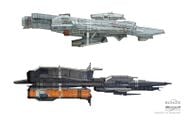Halo: Chronicles
From Halopedia, the Halo wiki
Halo: Chronicles was a video game project set in the Halo universe in development for the Xbox 360. Described as an "episodic interactive storytelling" project,[1] Chronicles was to be developed by WingNut Interactive, a video game development studio formed in 2006 from a partnership between Microsoft Game Studios and director Peter Jackson. Chronicles was in development since 2006[2] but was ultimately cancelled in 2009.[3]
Development and design[edit]

- "Joe came up with the concept of “be the bullet”. We wanted to take the player on this emotional and gameplay journey from just being human to being a modified human. Not modified in the sense that you just put on power armor, but where there’s biological shit actually happening to you."
- — Paul Bertone[2]
While Chronicles was in development, a select team of Bungie employees - namely Joseph Staten and design director Mike Woo - was working in New Zealand with Jackson. Gameplay designer Paul Bertone was involved as well for some time around the time of Halo 3's release.[2] When Chronicles was later cancelled, the team returned to Bungie to work on Halo 3: ODST instead.[4] Staten in particular had a key role in coming up with Chronicles's story, as well as advising the WingNut writing team.[2]
It was stated that Chronicles would "focus on the intimate, personal aspect of war."[5] The player would have been an ordinary Marine rather than a Spartan and thus also weaker than in the prior games. Over the course of the game, however, the player character would acquire an "alien arm" and eventually be transformed into a powerful Forerunner warrior known as a Promethean.[2] The player character was later stated by Paul Russel to be a human miner who had been captured by the Covenant and subjected to their slavery, before finding the technology that would set him on his journey.[6]
The player would be able to switch into a different combat mode in which the only way to deal damage was through a powerful melee attack. Two weapons were available: one that would push enemies away, while the other would stun them in place. Other features included a double jump and an auto-aimed long-distance dash that could be initiated from mid-air. Many basic gameplay features were prototyped, notably a lowered camera and jump height, a slowed-down movement, and no recharging shields. These features were tested in modified versions of the first five missions of Halo 3. The team found that they could downgrade surprisingly many of the player's base traits, although fewer alterations were made to weapons. Since the player would have been weaker, modifications were made to enemy behavior to retain gameplay balance. Paul Bertone and engineer Damian Isla worked on an enemy AI system called "kung-fu", in which only a couple of enemies would attack the player at a time even if more enemies were present; the others would either be hiding or in cover, only revealing themselves sporadically. Eventually, when the player was fully Promethean, they would be flying in low orbit and fighting Covenant cruisers with the ability to turn into a missile and target specific parts of the ships. Gameplay prototyping for Chronicles was relatively far along, although because the story remained unfinished, the gameplay team could not start actually designing the campaign missions.[2]
Ultimately, enthusiasm for the Chronicles project dropped as the Peter Jackson Halo film deal was cancelled; additionally, Bungie was beginning to have creative differences with the WingNut team.[2] After its cancellation, many of the gameplay features prototyped for Chronicles made it into Halo 3: ODST. Meanwhile, the concept of the Prometheans was later reintroduced into the Halo canon via The Forerunner Saga and Halo 4. Some story concepts developed for Chronicles resurfaced in the Neill Blomkamp film District 9, in which the human main character slowly transforms into an alien in a rather similar fashion as in the planned story of Chronicles. Additionally, the film allegedly re-used many of the props originally created for the Halo film project. According to Bertone, Staten "had trouble" seeing the film because of its overt parallels to his story ideas.[2]
Several corporate starships were concepted by Isaac Hannaford for Halo: Chronicles.[7][8] He described them as used by a corporation, and said the ships were a mix of military and civilian themes. They are equipped with limited weapons and transport mercenaries and scientists.[9] Hannaford also designed a helmet for use by corporate security forces in the game; this helmet was later reused for the GUNGNIR-class Mjolnir helmet in Halo: Reach.[10]
Concept art by Isaac Hannaford, noted by him to depict a corporate starship near an asteroid.[11]
Production timeline[edit]
Announcement and development[edit]
- In 2005, Peter Jackson first visits Bungie, marking the beginning of his collaboration with the studio.[2]
- On September 27, 2006, Halo: Chronicles was announced alongside Halo Wars at Microsoft's X06 trade show in Barcelona, Spain.[12]
- On March 7, 2007, Microsoft executive Shane Kim revealed that "two episodic series... the first [of which] is in the Halo universe" were still in early design phases.[13][14]
- On May 14, 2008, Kim states that Microsoft were in talks with Jackson about how "[they] can use Live as a medium to introduce episodic interactive storytelling".[15]
- On August 1, 2008, it was reported that Microsoft were still hiring for Chronicles, specifically for the creative director role, adding that candidates will be required to "bridge the gap between storytelling and the interactive experience while delivering on the Halo soul."[16]
Cancellation[edit]
- On July 24, 2009, the project was announced as cancelled, although Microsoft was "still looking into it" without the involvement of Jackson.[3] Jackson later stated the project "...sort of collapsed when the movie didn't end up happening."[17]
- On July 28, 2009, Microsoft stated "we’ve decided to put this joint effort on hold and prioritize resources against other projects like Halo 3: ODST, Halo: Reach and Halo Legends."[18]
Notes[edit]
Sources[edit]
- ^ GamesRadar, "I've never heard of a motion-sensing controller... (Retrieved on Mar 22, 2022) [archive]
- ^ a b c d e f g h i VICE, The Complete, Untold Story of Halo (Retrieved on Mar 21, 2022) [archive]
- ^ a b IGN, Peter Jackson's Halo Dead (Retrieved on Mar 22, 2022) [archive]
- ^ Kotaku, How And Why Halo 3: ODST Was Made In 14 Months (Retrieved on Sep 12, 2009) [archive]
- ^ CVG, Xbox Previews: Halo Wars (Retrieved on Mar 26, 2008) [archive]
- ^ Twitter, Paul Russel (@docabominable): "That was a weird ass story. A human miner, slave of the covenant, finds bits of forerunner tech that binds to him and he becomes a forerunner spartan, leads a rebellion, forms himself into a javelin and Captain Marvels through Covenant ships like they were butter." (Retrieved on Apr 27, 2022) [archive]
- ^ ArtStation, Halo 3 Spaceship designs and discards (Retrieved on Sep 27, 2021) [archive]
- ^ Twitter, Isaac Hannaford (@Isaac_Hannaford): "These were for the Peter Jackson related project" (Retrieved on Apr 27, 2022) [archive]
- ^ Space Ship Guru, Concept Ships: Comments section by Isaac Hannaford "the bottom two ships are a mix. They're owned by a corporation and they have some limited weapons mostly they just haul around mercenaries and scientists." (Retrieved on Sep 20, 2021) [archive]
- ^ Twitter, Isaac Hannaford (@Isaac_Hannaford): "I did not. Gungnir was actually a corporate security helmet for Peter Jackson’s Halo game. It didn’t happen so I repurposed it" (Retrieved on Oct 13, 2023) [archive]
- ^ BlueSky, Isaac Hannaford: "an unused concept for the Peter Jackson Halo. A mining ship station keeping an asteroid" (Retrieved on Jun 17, 2025) [archive]
- ^ Bungie.net, Bungie Weekly Update: 4/25/08 (Retrieved on Jan 16, 2020) [archive]
- ^ Joystiq, Peter Jackson working on episodic Halo content (Retrieved on Mar 17, 2007) [archive]
- ^ Gamasutra, GDC: Microsoft Talks Episodic Halo Xbox 360 Series (Retrieved on Mar 22, 2022) [archive]
- ^ CVG, Shane Kim (Retrieved on Apr 7, 2011) [archive]
- ^ CVG, Microsoft STILL hiring for Halo Chronicles (Retrieved on Oct 25, 2022) [archive]
- ^ Joystiq, Peter Jackson: Halo Chronicles "no longer happening (Retrieved on Jul 26, 2009) [archive]
- ^ Video Games Blogger, Halo Chronicles not cancelled but on-hold, says Microsoft (Retrieved on Mar 22, 2022) [archive]
| ||||||||||||||||||||||||||||||||||||||||||||


![Concept art by Isaac Hannaford, noted by him to depict a corporate starship near an asteroid.[11]](https://halo.wiki.gallery/images/thumb/9/9a/HCr_AsteroidShip_Concept.jpg/58px-HCr_AsteroidShip_Concept.jpg)
